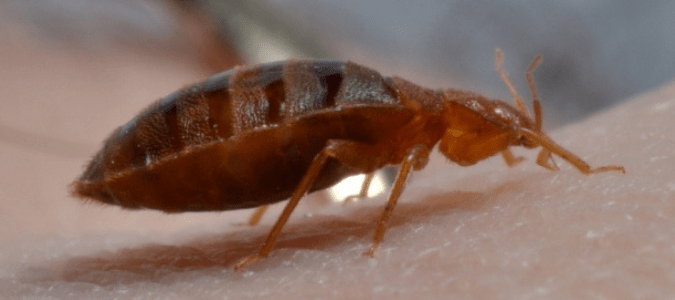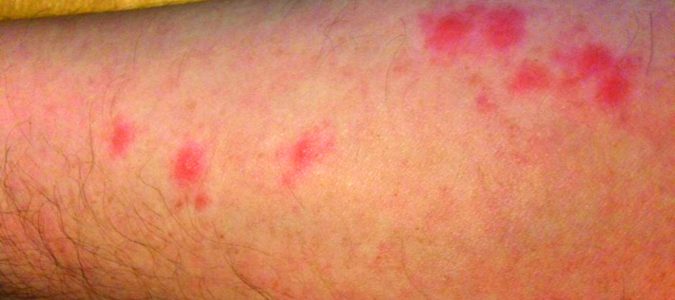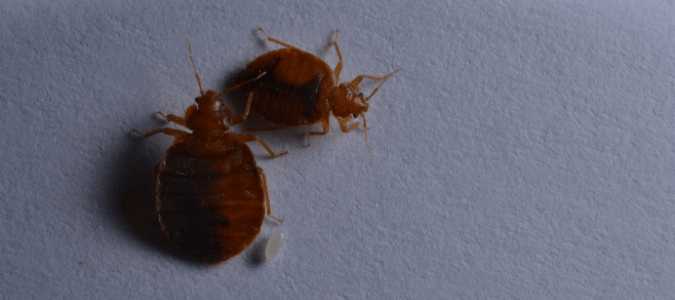Bed bugs are annoying and unwelcome pests. These small, oval, brownish insects feed on the blood of humans and animals. An adult bed bug is about the size of an apple seed and tends to swell and turn reddish after feeding.
Unlike ants or bees, these pests don’t build nests but hang out in groups in dark, out-of-the-way hiding places. These often include mattresses, box springs, bed frames and headboards.
In time their numbers can increase as they seek other hiding spots, including other nearby rooms. Bed bugs can be found almost anywhere there’s potential for a suitable host.
Do Bed Bugs Jump?
Bed bugs make use of anyone traveling from place to place. These unwanted hitchhikers will hide in the creases and folds of just about any mode of transport, including suitcases, backpacks, bedding and furniture.
Unlike fleas, which can jump great distances, bed bugs have no jumping abilities and must instead crawl across the ground and up walls or ceilings to reach potential hosts.
Many homeowners are surprised to learn just how fast bed bugs move. Bed bugs can crawl surprisingly fast—three to four feet per minute on most surfaces. That may sound like a little, but that’s the equivalent of a human sprinting.
If you think these pests have made their way into your home, search for evidence of living bed bugs. In addition to bites, small blood spots on your sheets or mattress often indicate that bed bugs are in the area.
Keep in mind that these invaders can squeeze into any tiny crack or crevice in beds, furniture and even cracks in the walls, making them difficult to locate. These pests can fit into crevices the width of a credit card. Contact a pest control specialist for positive identification if you think you have an infestation.
Can Bed Bugs Only Bite One Person?
As you sleep, the carbon dioxide you emit draws bed bugs to you. Their bites are usually found on exposed areas such as the neck, shoulders, arms and legs.
Since bed bugs are equal opportunity biters, they will bite anyone they can to get a meal. Bite marks from bed bugs can take up to 14 days to show up in some people, so it can sometimes seem like bed bugs are just biting one person. Their bites will become more obvious as they multiply and spread throughout your home.
Unfortunately, you probably won’t be able to catch them biting you. Bed bugs inject an anesthetic when they bite to numb the area first. Also, don’t expect each bite to signify a single bug. These pests often bite multiple times during the night.
People who have been bitten may notice small, itchy bumps. While these may resemble mosquito bites at first glance, they can be itchier and more annoying than the flying insect’s bite. It’s helpful to know what bed bug bites look like, so you can quickly identify them.
Bed Bug Bites
Even though bed bugs are tiny pests, the size and appearance of their bites may vary between individuals. It might be possible, for example, that someone does not exhibit any reaction to a bite or even for the same bed bug to bite two different people resulting in different outcomes. One may have no response at all, while the other could develop an itchy rash.
Similarly, you may not notice any discomfort or reaction at all, at least not on your first exposure. This is because it can take several days or even a week before the skin starts to react. Over time, your body may stop reacting to the bites. However, this doesn’t mean that the bed bugs just went away. You will still need to contact a pest control professional to get rid of the pests.
Bed bug bites usually appear randomly on any exposed body area, whereas flea or chigger bites typically appear primarily around the ankles. Furthermore, bed bug bites don’t normally have a red dot, while flea bites often include one.
Bed bug bites also tend to linger longer than mosquito bites.
Though not known to spread diseases, bed bugs’ presence can lead to uncomfortable skin itching, disruption of sleep and potential skin infection caused by excessive scratching of the affected areas.
How To Treat Bed Bug Bites
While they usually heal on their own, there are a few steps one should take to make sure they heal quickly without developing an infection.
Cleaning the area with soap and water can help. This can relieve itchiness and lower the risk of infection.
Most bed bug bites will clear up within a couple of weeks. Some people, however, may experience more serious allergic reactions like fever or even difficulty breathing. You should seek medical attention immediately if you exhibit any of these symptoms.
When mysterious itchy bite marks start appearing, it can be difficult to identify the culprit. Bed bugs could potentially be the suspect, so it’s important to know what steps to take. Reach out to a pest control professional if you notice bed bug bites or other signs of these pests.
How Far Do Bed Bugs Travel?
Bed bugs have a remarkable ability to withstand hunger and extreme temperatures. This allows them to move long distances, even up to 20 feet in one night, from their hiding places in search of a fresh meal.
While eight feet is usually the limit for finding the pests close to sleeping areas, their potential for infesting multiple locations is incredibly alarming.
Bed Bug Hiding Places
Check even the smallest hiding places if you find yourself in a room severely infested with bed bugs. These pesky critters are only about the width of a credit card, so there are many hiding places for bed bugs.
You may find them in furniture seams and cushions, under wallpaper and inside electrical outlets. Even seemingly harmless places, such as drawer joints and the junction between a wall and ceiling, could be riddled with bed bugs!
Make sure to look closely. If something looks suspicious, contact a pest control specialist to investigate further.
Despite being often found inside mattresses or nearby furniture, bed bugs can also take up residence in your carpets. Because of their size, they’ll often remain close to the surface, which makes it harder to spot them.
Do DIY Methods Work To Control Bed Bugs?
DIY sites often tell you that you can get rid of these pests by using natural home remedies such as alcohol or essential oils. While you might find some success with these remedies, you would have to know all of their hiding spots to target every bug.
Ultimately, bed bugs are incredibly difficult to detect and handle due to their ability to hide.
Fighting bed bugs can seem like an overwhelming task. Without knowledge and experience, it is virtually impossible to find every single bed bug. Even if you find relief with DIY solutions, chances are that you will find it a short-term fix instead of solving the problem.
Given how difficult it is for the typical homeowner to handle these infestations, seeking help from an expert is the best way forward. DIY products cannot come close to providing the same results as an experienced pest control provider. A specialist can identify bed bug hiding places and implement an effective pest control strategy. They tailor these methods to address the extent of each infestation.
Ultimately, a qualified, professional pest control service is an invaluable asset in eliminating bed bug populations that simply cannot be done with DIY methods.
ABC Can Control Your Bed Bug Problem
Bed bugs are skilled at hiding and multiply quickly, meaning a small problem can quickly become an overwhelming infestation. When you notice signs of bed bugs, contact ABC Home & Commercial Services. We have many strategies to control bed bugs, so you don’t have to worry about these pests.



